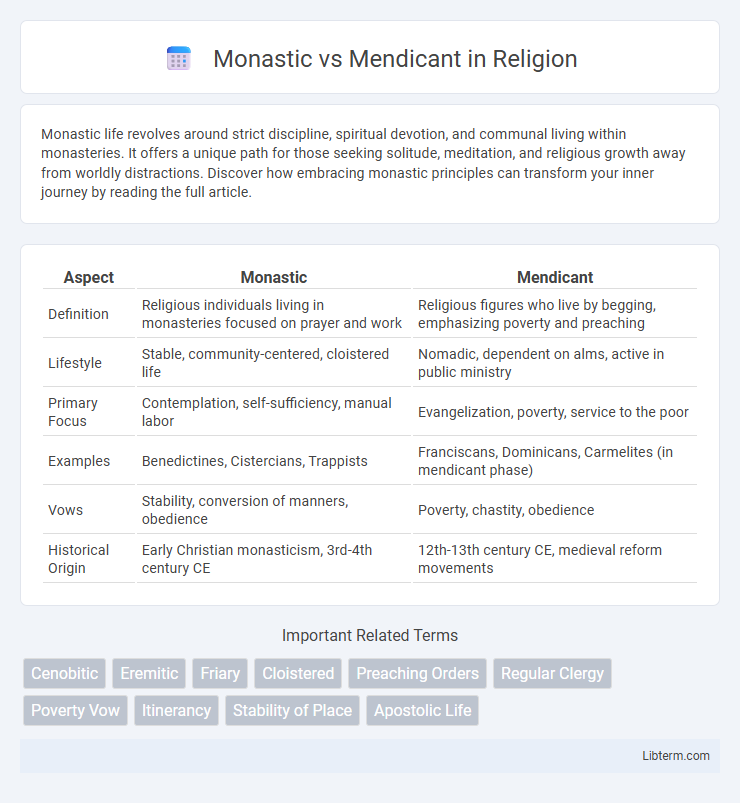Monastic life revolves around strict discipline, spiritual devotion, and communal living within monasteries. It offers a unique path for those seeking solitude, meditation, and religious growth away from worldly distractions. Discover how embracing monastic principles can transform your inner journey by reading the full article.
Table of Comparison
| Aspect | Monastic | Mendicant |
|---|---|---|
| Definition | Religious individuals living in monasteries focused on prayer and work | Religious figures who live by begging, emphasizing poverty and preaching |
| Lifestyle | Stable, community-centered, cloistered life | Nomadic, dependent on alms, active in public ministry |
| Primary Focus | Contemplation, self-sufficiency, manual labor | Evangelization, poverty, service to the poor |
| Examples | Benedictines, Cistercians, Trappists | Franciscans, Dominicans, Carmelites (in mendicant phase) |
| Vows | Stability, conversion of manners, obedience | Poverty, chastity, obedience |
| Historical Origin | Early Christian monasticism, 3rd-4th century CE | 12th-13th century CE, medieval reform movements |
Defining Monastic and Mendicant Traditions
Monastic traditions center around communities of monks or nuns who live in monasteries, emphasizing stability, communal living, and a life dedicated to prayer and work within a fixed location. Mendicant traditions involve itinerant religious orders, such as the Franciscans and Dominicans, who rely on alms and actively engage with society by preaching and serving the poor. These two distinct approaches reflect differing spiritual priorities: monasticism values seclusion and contemplation, while mendicant orders focus on mobility and missionary outreach.
Historical Origins and Development
Monasticism originated in the early Christian centuries, characterized by monks living in isolated communities dedicated to prayer, work, and asceticism, exemplified by figures like St. Benedict in the 6th century. Mendicant orders emerged in the 13th century, with friars such as St. Francis of Assisi promoting itinerant preaching, poverty, and active engagement in urban centers. The development of monasticism focused on stability and enclosure, while mendicant movements emphasized mobility and reliance on charity to address the spiritual needs of growing medieval cities.
Core Philosophies and Spiritual Goals
Monastic traditions emphasize stability, communal living, and strict adherence to prescribed rituals aimed at spiritual purification and enlightenment within a fixed location. Mendicant orders prioritize itinerant lifestyles, relying on poverty and active engagement with the community to cultivate humility and spiritual growth through service. Both approaches seek transcendence, yet monasticism centers on withdrawal from worldly attachments, while mendicancy embraces interaction and dependence on alms as spiritual discipline.
Daily Life: Structure and Routine
Monastic daily life revolves around a strict, regimented schedule structured around communal prayer, meditation, and manual labor, emphasizing stability and self-sufficiency within the monastery. Mendicants follow a more flexible routine, often moving between locations, focusing on preaching, almsgiving, and serving communities while depending on charity for sustenance. The monastic lifestyle prioritizes enclosure and contemplation, whereas mendicant life centers on active engagement and itinerant ministry.
Approaches to Poverty and Possessions
Monastic communities embrace communal living with shared ownership of property and resources, emphasizing stability and self-sufficiency to avoid personal poverty. Mendicant orders practice radical poverty by renouncing material possessions entirely, relying on alms and charitable support for sustenance, reflecting their itinerant lifestyle. The monastic approach centers on controlled resource management within monasteries, while mendicants prioritize spiritual detachment through dependence on external generosity.
Religious Orders: Key Examples
Monastic religious orders, such as the Benedictines and Cistercians, emphasize stability, communal living, and manual labor within a monastery. Mendicant orders like the Franciscans and Dominicans prioritize itinerant preaching, poverty, and urban ministry over fixed residence. These distinct approaches reflect differing spiritual goals and societal roles within Christianity.
Community Living vs. Itinerant Mission
Monastic life centers on stability within a communal setting, where monks dedicate themselves to prayer, work, and study in a fixed monastery. Mendicant orders emphasize itinerant mission, traveling to preach, teach, and serve communities without permanent residence. This contrast highlights monastic commitment to communal roots versus mendicant engagement with diverse public environments.
Role in Medieval Society and Influence
Monastic orders like the Benedictines played a crucial role in medieval society by preserving knowledge through manuscript copying and providing stable centers of education and agriculture. Mendicant orders, such as the Franciscans and Dominicans, influenced urban society by preaching, serving the poor, and engaging in active missionary work, thus shaping religious and social practices in growing cities. The distinct roles of monastics and mendicants contributed to the spiritual, intellectual, and social fabric of medieval Europe.
Legacy and Contemporary Relevance
Monastic traditions, rooted in stable communities dedicated to contemplation and self-sufficiency, have left a lasting legacy influencing Western spirituality, art, and education through institutions like Benedictine monasteries. Mendicant orders, emerging in the 13th century with figures such as St. Francis of Assisi, introduced a dynamic model of itinerant preaching and poverty that reshaped religious engagement and social outreach. Contemporary relevance of monasticism is seen in mindfulness and retreat practices, while mendicant ideals inspire modern social justice and charitable movements, demonstrating ongoing influence in spiritual and humanitarian spheres.
Monastic and Mendicant Traditions Compared
Monastic traditions emphasize stability, communal living, and strict adherence to a rule, often involving vows of poverty, chastity, and obedience within a fixed monastery. Mendicant traditions prioritize poverty, itinerant preaching, and reliance on alms, with orders like the Franciscans and Dominicans actively engaging with urban communities. Both approaches shape Christian spiritual life through contrasting commitments to rooted community versus mobile ministry, influencing doctrinal practice and socio-religious roles.
Monastic Infographic

 libterm.com
libterm.com